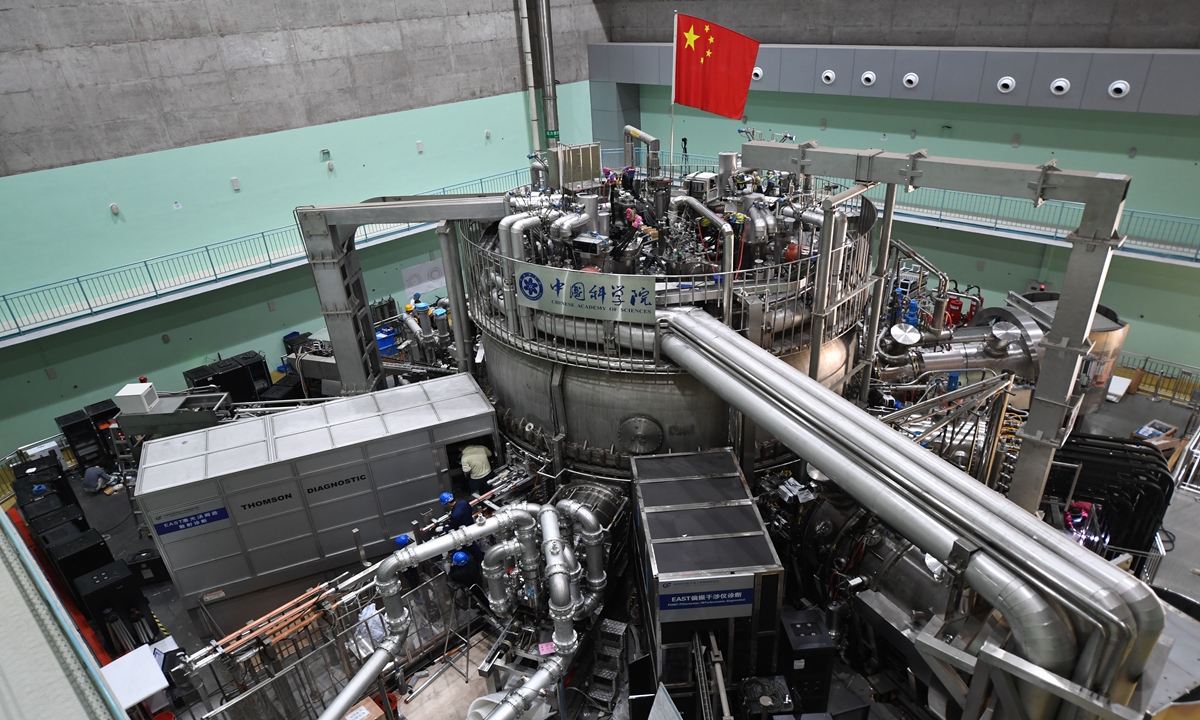
Chinese "artificial sun" -- Experimental Advanced Superconducting Tokamak Photo: VCG
A viral tweet that allegedly included a video of China's "artificial sun" was actually the launch of a Chinese carrier rocket, according to media reports.
The video posted by Twitter account "AuxGod" became a social media meme on Monday and had gained 13,900 likes and 5.8 million views as of press time, with a 24-second-long video showing a bright orange light source rising rapidly from the horizon.
The tweet described the footage as "China's 'artificial sun' setting a new world record after superheating a loop of plasma to temperatures five times hotter than the sun for more than 17 minutes.
Reviewing the video, it is clear that people were saying "the rocket was launched," in Putonghua on the ground. Domestic news outlet the paper.cn reported on late Tuesday that the video was possibly a recording taken during the launch of China's Long March-7A on December 23, 2021 at the Wenchang launch center, South China's Hainan Province, following technical analysis.
Netizens left comments under the video saying they thought it was the real scene of the launch of a Chinese "artificial sun" and started to discuss the purpose of the launch. Netizen @neonsquirrel86 questioned the purpose of the launch and stated that "we've got plenty of other human problems we should address first."
Meanwhile, other netizens found problems with the video. "This is obviously a rocket launch," said @mrchan, who also attached a news link about a Chinese "artificial sun" reported by South China Morning Post.
However, an aerospace expert pointed out there is indeed some linkage between the two objects other than the fact that both are top-notch technologies developed by China.
Huang Zhicheng, a senior expert on aerospace science and technology, told the Global Times on Wednesday that one of the original concepts for an "artificial sun" developed by mankind is to set up a charging station in space to provide energy for satellites.
"The conversion rate of solar radiation in space is much higher than on earth, which has a thick atmosphere, so charging satellites in space with a so-called artificial sun is actually a reasonable concept," Huang said.
However, he noted that the launch of massive charging equipment into space is a problem yet to be solved. China's current research into an "artificial sun" is based on Earth and conducted via nuclear fusion.
A new round of experiments for the Chinese "artificial sun" - Experimental Advanced Superconducting Tokamak (EAST) - kicked off at the Hefei Institutes of Physical Science under the Chinese Academy of Sciences on December 30, the Xinhua News Agency reported, setting a new record for fusion reaction duration of 1,056 seconds.
The ultimate goal of EAST is to create nuclear fusion used by the sun to provide a steady stream of clean energy, and widely apply the technique in areas such as cancer treatment, maglev trains and nuclear magnetic resonance.
"The technology for nuclear fusion has existed for about 100 years and China has made remarkable breakthroughs in the field, but there is still a gap before we can launch an 'artificial sun' in space," Huang said.
Global Times




